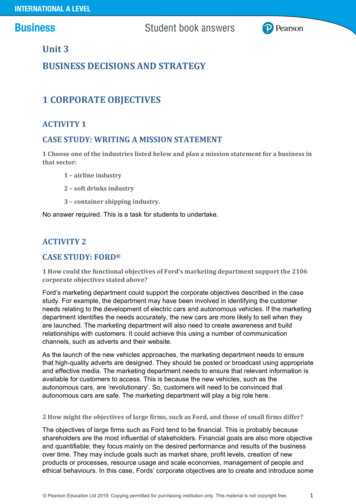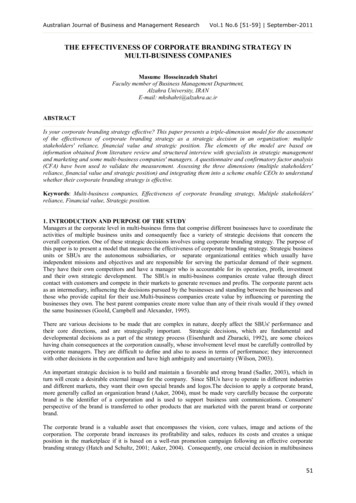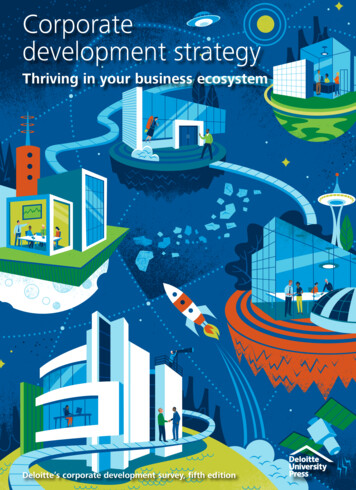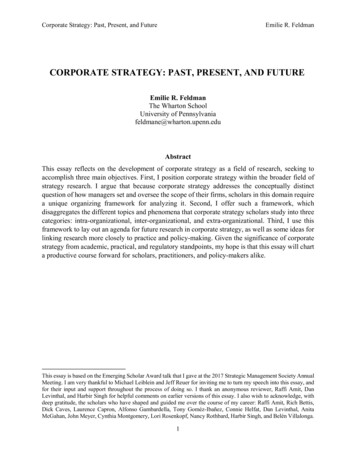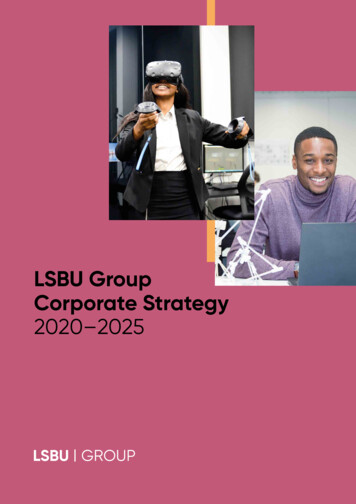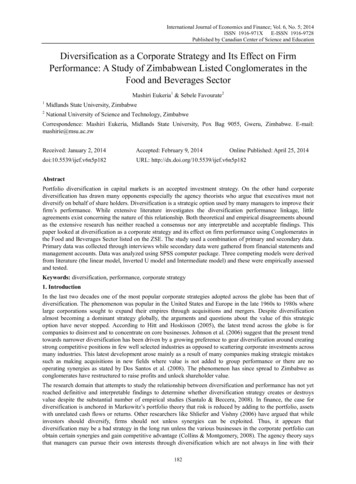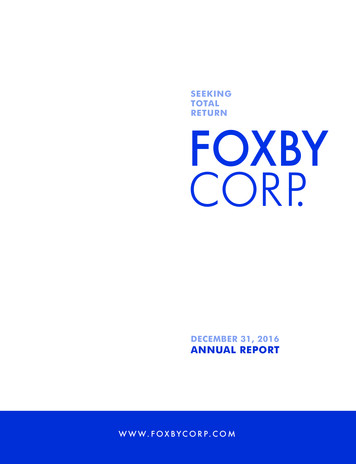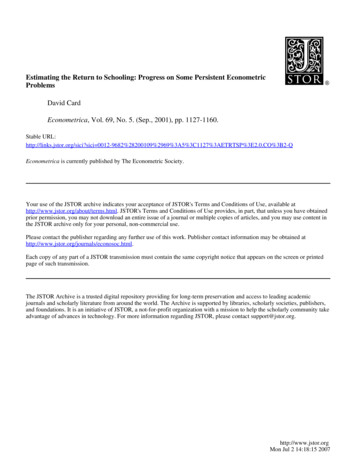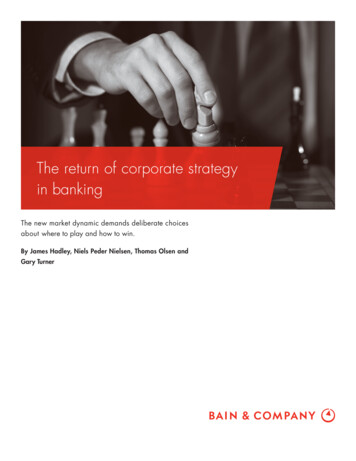
Transcription
The return of corporate strategyin bankingThe new market dynamic demands deliberate choicesabout where to play and how to win.By James Hadley, Niels Peder Nielsen, Thomas Olsen andGary Turner
James Hadley leads Bain & Company’s Strategy practice in Europe, the MiddleEast and Africa. He is based in London. Niels Peder Nielsen, Thomas Olsenand Gary Turner are partners in Bain’s Financial Services practice, and they arebased, respectively, in Copenhagen, Singapore and Sydney.Net Promoter ScoreSM is a trademark of Bain & Company, Inc., Fred Reichheld and Satmetrix Systems, Inc.Copyright 2015 Bain & Company, Inc. All rights reserved.
The return of corporate strategy in bankingFor many years, corporate strategy languished in bankingcircles. During the go-go 1990s and most of the 2000s,too many bankers pursued indiscriminate growth,had a broad appetite for risk and diversified their portfolios without worrying enough about controlling costsor staking out distinctive positions in the eyes of customers.The times demand that banks relearn strategy. Banks’sources of revenue have come under pressure: Creditgrowth has slowed as consumers and businesses havedeleveraged, net interest margins have been squeezed,and fee income has come under pressure due to increasedcompetition and consumer watchdogs’ focus on unfairpractices. At the same time, new digitally based entrantswith disruptive business models, such as eToro andKabbage, have been attacking lazy profit pools andtaking share from incumbent banks. Several waves ofregulation have introduced ever stricter and highercapital requirements, reducing banks’ own balancesheet leverage.Then, the 2008 financial crisis caused an abrupt aboutface from growth to survival. Many bankers wieldedblunt restructuring tools to take out costs and deleverage their balance sheets in order to meet regulators’capital adequacy requirements. While most of thesemeasures were necessary, they certainly did not setthe stage for future growth. The majority of banks reliedon the same tactics of cost takeout, branch networkpruning and performance improvement over the pastfive years, yet the industry’s return on equity droppedby 6 percentage points since before the crisis, and continues to decline (see Figure 1).Figure 1:The new macro and competitive environment meansthat banks have to adapt through more disciplined strategy. At some banks, what passes for strategy, in factconsists of the pursuit of quarterly profit targets. Along-term growth strategy, by contrast, often meansBanking has experienced falling returns and a widening gap between winners and losersGlobal banking industry average return on equityAnnualized total shareholder return, largest 20 banks30%30%Financial 072006200520042003200220010Standarddeviation1993 20032003 20135%9%Single companyIndustry averageNote: Industry average calculated from all global banks for which data is available through SNL; return on equity calculated as net profit as a percentage of total equitySource: Bain & Company analysis of SNL data (n 898 North American banks, 210 European banks, 280 Asia-Pacific banks and 33 Latin American banks)1
The return of corporate strategy in bankingenduring some pain over the short term and explainingto shareholders why it takes time to deliver results.The old, blunt strategic playbook took a resource-ledapproach to the portfolio that ranked businesses withinexisting constraints of risk, capital and liquidity, leadingto short-term (one- to two-year) planning. A more effective approach to strategy defines decisions that candistinguish the bank from competitors in the eyes ofcustomers and that allow the bank to beat competitorsthrough cost leadership, superior customer service orother means. This approach takes a three- to five-yearplanning horizon, with a target portfolio that determinesrisk, capital and liquidity boundaries.To be sure, many challenges today—including low interest rates, high nonperforming loans in some countries and a regulatory backlash in many regions—havesome element of cyclicality. Observers taking an extremeposition could argue that banks in southern Europewill continue to lag no matter what their strategy is andthat US banks can expect stronger growth once interestrates rise. Bankers who buy the cyclical explanationmight feel as though they have limited options or shouldnot make material changes.Writing a new playbook requires makingreal choicesWe believe that cyclical effects, though real, do notpresent a complete picture. Some banks perform betterthan others in the same conditions, and the winnersover long periods manage the structural as well as thecyclical elements.Any strategy should take into account the starting pointand the customer, competitive, technological and regulatory trends affecting a bank and its markets. It shouldalso equip the bank to manage through financial marketand economic cycles, being explicit about the risk exposures desired and how to adjust those exposuresthroughout the cycle. Accomplishing both goals entailsdefining a much broader set of options than most bankshave considered regarding their business portfolio, riskappetite and capital allocation.Strategy should define the attractivemarkets, ways to develop a strong position in those markets and the few distinctive assets and capabilities that set abank apart.Strategy should define the attractive markets and whethera bank can develop a strong and sustainable positionin those markets so that it can build a few distinctiveassets and capabilities that set it apart. Differentiationcomes not from baseline steps such as moving activitiesonline but rather by sculpting features that will inducecustomers to take out a mortgage or invest their wealthwith one bank over its competitors.Consider that the gap in total shareholder return between the best and worst of the 20 largest banks worldwide has widened from a 5% standard deviation fromthe average return between 1993 and 2003 to 9% overthe 2003–2013 period. Clearly, different business choicesled to different financial outcomes.Making choices about what type of bank to becomeis a central issue for all banks today. Bain’s analysisof 250 banks globally shows that only 1 in 9 are sustainedvalue creators—we define this group as banks that beatthe competition on revenue and earnings growth overthe 10-year period, while delivering total shareholderreturn greater than the cost of capital.For many banks, then, a last call for creating a sustainable advantage is approaching. They will need to stretchdormant strategy muscles at the enterprise level. Thisgoes well beyond ranking current businesses based ontheir financial contribution, because that exercise cannotpredict what will deliver future returns.In our sampling, 65% of the sustained value creators(by number of banks) are local or regional, multi-category2
The return of corporate strategy in bankingFigure 2:About 65% of sustained value-creating banks use local or multi-country universal modelsSustained value creatorsLocal universalUniversalRetail/Commercial China MerchantsICICIItaúZachodni WBKSpareBankMulti-country universal48% JPMorgan Chase17%Local retail/commercialMulti-country retail/commercial People’s United Shanghai Pudong Development Silicon Valley Bank Westpac13%Pure playGlobal universalANZCIMBNational Bank of Abu DhabiScotiabank4%Global retail/commercial4%Local pure playMulti-country pure play HDFC TD9%0%Global pure play4%LocalMulti-country0%GlobalNote: Only a few examples of the sustained value creators shown. Sustained value creators are banks with 10-year inflation-adjusted net revenue and earnings before tax (EBT)growth of more than twice their country’s real GDP, with a minimum of 5.5%; a starting-year EBT margin of more than 2%; and total shareholder return over the period greaterthan their cost of capital.Sources: Bain & Company analysis of CapIQ and bank financial reportsonce enjoyed due to synergies has been reversed, withsome global banks posting an ROE disadvantage aslarge as 3 percentage points, according to Bain analysis.Now, a few global universal banks, such as Royal Bankof Scotland and Deutsche Bank, have started to moveaway from—or adapt—the model, exiting countriesand splitting off large business units. Others, such asJPMorgan Chase and HSBC, conceding that the penalties have shifted the balance, seek to make consciouschoices to ensure that the economics are sustainable.banks. By contrast, only 4% of sustained value creatorsfit the global universal model, which is a smaller sharethan the 7% of total banks that fit the global model(see Figure 2). Most of the global universal banks extended their footprint so broadly that they now have along tail of subscale countries or products that don’tyield leadership economics. For years, given positivemacroeconomic trends and reasonable growth in emergingmarkets, global universal banks were not required toprove that synergies of scope, scale and funding exceededthe potential drawbacks of complexity and controlchallenges. However, slower economic growth, increasingly sophisticated local competitors and recent regulatorychanges have imposed significant penalties for beingglobal and universal. That forces global universal banks toreassess the value of this model.Customers notice these choices. In retail banking, forinstance, large national banks’ Net Promoter ScoreSM,a well-established measure of customer loyalty, in somecountries still lags behind direct banks, cooperativesand credit unions—institutions that tend to have clear,focused strategies and that explicitly choose not to docertain things so that they can excel at their core offerings.The result: The 3-percentage-point return on equityadvantage over other banks that global universal banks3
The return of corporate strategy in bankingFigure 3: Strategy involves making deliberate choices in three areasWhat are our possible paths to full potential? To what extent will it be necessary toredefine the basis of competition andreshape the industry?Play by, bend or break the rules ofthe game What is my risk/return appetite?Risk rating, guardrails for liquidity andcapitalization, parameters for own trading How far can I stretch returns?Through cost leadership, premium services,capital efficiency, inexpensive funding, etc. How fast can I grow?Organically or through M&AAmbitionWhat are our portfolio choices?Where to playHow to winWhat sources of competitiveadvantage will beat competingbanks and attackers? Scale and its full benefits Valuable proprietary assets Superior capabilities Geographies tocompete in Attractive customer segmentsto target and retain Product lines to offer and prioritize for cross-selling Parts of the value chain to participate inSource: Bain & CompanySome leading banks, therefore, are making strategicchoices from a set of options that feel radically differentfrom one another, rather than being a variation on atheme. Their decisions cluster in three areas: the bank’soverall ambitions; where it should play by country, product and customer segment; and how it can win in eachchosen market (see Figure 3).tomer experience. That vision shapes how CBA designsits propositions around the customer’s perspective—for example, designing its service around the entireevent of “buying a home” rather than the narrower actof “selling a mortgage.”Besides a compelling vision, defining the ambition involves choices concerning what balance of risk and return to adopt. This will depend partly on investors’ appetitefor risk. Rabobank, a member-owned cooperative bankin the Netherlands, has defined its risk and return objectives consistent with its members’ appetite. “Rabobank’sbusiness strategy is based on its cooperative background,”the bank says, “and thus maximization of profit is notan objective.”What’s your ambition?Setting a bank’s ambition at the enterprise level involvesarticulating a vision that’s both inspiring for employeesand specific enough to enable choices as opposed tovague, feel-good aspirations. The vision can encompasswhat the mix of businesses and geographies will looklike and the desired competitive position.Where should you play?Commonwealth Bank of Australia (CBA), for instance,has the stated ambition of being Australia’s finest financial services organization through excelling in the cus-Once the ambition is set, what should the businessportfolio mix look like in terms of geographic focus,4
The return of corporate strategy in bankingcustomer segments, product lines and parts of the valuechain? Just as important, what links the businessesand could make the whole worth more than the sumof the parts? This question concerns not only cost andplatform sharing or customer overlaps. Liquidity andfunding have always been crucial in a balance-sheetbusiness, but new regulations and near-death experiencesshould force bankers to more explicitly consider tradeoffs and asset/liability linkages.segments within each one. In small business lending,for instance, it is becoming increasingly important topursue fee-based transactional activities such as cashmanagement. In consumer markets, few banks canbe all things to all people, so it may be better to exitserving a particular segment if you cannot deliver adifferentiated experience.For any given product or segment, banks also have arange of choices about how to source and deliver thegoods—their own product, a co-branded product, thirdparty investment vehicles, in-house vs. outsourcedprocessing and so on. Royal Bank of Canada distributes asset management products through third partiesand outsources investor/treasury services, for example,yet manages to lead in almost all categories in whichit competes.When weighing whether to keep or add a country or aproduct line, it makes sense to set a high hurdle. Forinstance, if you are the No. 5 player in Brazil, with relatively few international synergies and a lot of capitalrequired to break into the top 3, exiting may be thebest option.Choosing which customer segments to serve requiresa rigorous review of how capital and management resources would be allocated across consumers, smallbusinesses, multinational corporations and the sub-Viewing the portfolio in an integrated manner allows abank to choose the best businesses to pursue and avoidless attractive, subscale businesses. You can build thisFigure 4: Assess portfolio choices on relatedness, attractiveness and ability to winIllustrative bank portfolioStructuredfinanceHighInvest to increasemarket shareSmall andmediumbusinessCompetitiveposition— Mediumabilityto winDefend positions andtake advantage oflow-effort riculturalfinancingLowLowExpand tactically withlow effort, or come ( millions)Business attractivenessSource: Bain & Company5
The return of corporate strategy in bankingview based on an assessment of each business’s attractiveness, using metrics such as return on capital and segment growth, and the bank’s ability to win, using metricssuch as relative market share and relative customerloyalty scores (see Figure 4). Then you can set a strategyfor each business and allocate resources appropriately.sitions. While the models are not mutually exclusive,each depends on a different mix of key assets and capabilities. It’s difficult and resource-intensive to be greatat every capability; in fact, it’s not necessary or evenhealthy. Leading banks invest heavily in those few capabilities essential to realizing the strategy while being“good enough” where that’s sufficient (see Figure 5).How can you win?When banks make deliberate choices about where toplay, some banks often then jump right to tactical steps.Most sustained value creators, by contrast, first spendtime determining how they can win—for instance,how to become a trusted proposition in small businesslending and ancillary services, or which aspects of thebanking experience will truly delight their retail consumers and improve the bank’s economics.Leaders at the corporate center will needto develop a better understanding ofthe real profitability of their businesses,adjusted for risk and capital requirements.Distinctive how-to-win models in banking include product innovation (as pursued by China Merchants Bank),efficiency (Santander) and repeatable mergers and acqui-Santander illustrates the power of a clear focus on localscale and an industrial operating model. As one partof its growth strategy, Santander has built a portfolioFigure 5:Deciding how to win requires identifying which few capabilities matter most to the sPortfolio andcapital managementM&A, joint ventures,partneringRisk and regulatorymanagementBusiness unit strategyTalent and cultureRisk selectionand pricingCore processes andoperationsProduct and mer centricityand propositionAsset andcapital baseData and technologyDistribution alance sheetOperations/back officeSource: Bain & Company6Distribution/customer experience
The return of corporate strategy in bankingFigure 6: Santander’s efficiency model hinges on several key capabilities and ortfolio andcapital managementM&A, joint venturesand partneringRisk and regulatorymanagementHighly repeatable M&Amodel that aims for atleast 10% market sharein each marketRisk selectionand pricingAsset andcapital baseProprietaryassetsCore processes andoperations/Dataand technologyProduct and servicesolutionsTalent and cultureLocalized geographicunits and marketing, withglobal support on overarching functions such asrisk and ITGo-to-market(service/selling)Customer centricityand propositionFocused, sophisticatedfront-line tools andsales cultureStandardized, efficientprocesses and best-in-classIT systems result inlower costsBalance sheetBusiness unit tains leadershipposition in eachgeographic marketOperations/back officeDistribution/customer experienceSources: Bain & Company analysis, Santander financial reportsthat banks will make have big implications for investmentsin technology and talent, and will take time to implement.of retail leadership positions in Spain and Latin America,all characterized by efficiency derived through standardized operations and a shared global IT platform. Santanderexcels in a few capabilities—particularly, M&A, sales,operations and IT—that enable it to both target underperforming retail banks for acquisition as well as spurincremental performance improvement across theportfolio (see Figure 6).These changes demand more from leaders at the corporate center. For example, they will need to develop abetter understanding of the real profitability of theirbusinesses, adjusted for risk and capital requirements.While banks frequently used risk-adjusted return oncapital measures in the 1990s, many moved in theearly 2000s to a focus on operating profit, then movedto revenue or even volume of assets, which encouragedindiscriminate growth. Some banks only reestablisheda focus on return on capital measures after the financial crisis. Most banks could also stand to improvetheir policies on transfer pricing, capital allocation andincentives for executives and staff.Strategy was dead, long live strategyThe need to make strategic choices for long-term growthand performance has become more urgent for banksthan their leaders may realize. Customers are increasinglywilling to try disruptive models such as peer-to-peerlending or non-card payments systems. Local competitive dynamics also are changing—for instance, in developing markets, homegrown banks have been introducing more sophisticated services
The return of corporate strategy in banking 1 For many years, corporate strategy languished in banking circles. During the go-go 1990s and most of the 2000s, too many bankers pursued indiscriminate growth, had a broad appetite for risk and diversifi ed their po

